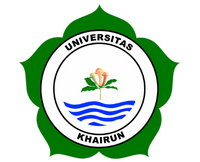Survival Rate and Food Utilization Rate of the Red Nila Fish (Oreochromis sp) Utilizing synthetic feed additives Seaweed (Gracilaria sp)
Abstract
In the fish farming business, feed is the highest operational cost, which reaches more than 60% of the total production cost. Therefore, the fish feed can be processed independently to reduce production costs in aquaculture businesses. This study aimed to determine the survival rate and feed efficiency of red tilapia (Oreochromis sp) fed artificial feed with the addition of seaweed (Gracilaria sp). This research was carried out from June to September 2021 at the Integrated Laboratory of Khairun University. This study used four treatments, and each treatment was repeated three times. The treatment tried is A (Artificial feed with the addition of Gracilaria sp 10 gr); B (Artificial feed with the addition of Gracilaria sp 20 gr; C (Artificial feed with the addition of Gracilaria sp 30 gr); and D (Artificial feed without the addition of Gracilaria sp.). The research variables included calculating the survival rate (SR), Feed Conversion Ratio (FCR), and observing water quality during the study. The highest survival value was in treatment B at 97.78%, while the lowest was in treatment A at 73.33%. The highest feed conversion ratio was in treatment D, 1.97, followed by treatments A and B, 1.48, and the lowest in treatment C, 0.64. The results of water quality measurements during the study, namely DO, range from 6-6.8 in all treatments, pH ranged from 7-7.6, and temperature ranged from 28-290C. The best survival rate (SR) of red tilapia-fed artificial feed with the addition of Gracilaria sp seaweed was best in treatment B, 97.78%, and the best feed conversion ratio (FCR) was in treatment C, which was 0.64 g.
Keywords
Full Text:
PDFReferences
Aliyas, Ndobe. S., dan Raihani Y.Z.. 2016. “Pertumbuhan dan Kelangsungan Hidup Ikan Nila (Oreochromis sp.) yang Dipelihara Pada Media Bersalinitas”. Jurnal Sains dan Teknologi Tadulako. Vol. 5 No.1 hal. 19-27.
Andriani R., dan Muchdar F. 2021. “Substitusi Pakan Buatan dengan Tepung Rumput Laut (Gracilaria sp.) Terhadap Pertumbuhan Ikan Nila Merah (Oreochromis sp.)”. Jurnal Agribisnis Perikanan. Vol. 14 No.2. hal 438-444.
Arifin M.Y. 2016. “Pertumbuhan dan Survival Rate Ikan Nila Strain Merah dab Starain Hitam yang Dipelihara Pada Media Bersalinitas”. Jurnal Ilmiah Universitas Batanghari Jambi. Vol. 16 No. 1 hal. 159-166.
[BRSDMKP] Badan Riset Sumber Daya Manusia Kelautan dan Perikanan. Pusat Pelatihan Kelautan dan Perikanan Balai Pelatihan dan Penyuluhan Perikanan Bitung. 2021. “Bahan Ajar Pelatihan Pembuatan Pakan Ikan Buatan”. Jakarta: Kementrian Kelautan dan Perikanan.
Cahyono B. 2000. “Budidaya Ikan Air Tawar”. Yogyakarta: Kanisus.
Dauhan R.E.S., Efendi E., dan Suparmono. 2014. “Efektifitas Sistem Akuaponik dalam Mereduksi Konsentrasi Amonia Pada Sistem Budidaya Ikan”. Jurnal Rekayasa dan Teknologi Budidaya Perairan. Vol 3 No. 1 hal. 297-301.
Effendie M.I. 1997. “Biologi Perikanan”. Yogyakarta: Yayasan Pustaka Nusantara.
Elyana P. 2011. “Pengaruh penambahan ampas kelapa hasil fermentasi Aspergillus oryzae dalam pakan komersial terhadap pertumbuhan ikan nila (Oreochromis niloticus Linn). Skripsi. Fakultas Matematika dan Ilmu Pengetahuan Alam, Surakarta: Universitas Sebelas Maret.
Ismail. 1991. “Budidaya Rumput Laut Alga Merah”. "Makalah Aplikasi Teknologi. Kupang, NTT.
Jaime O-V., Aguilera J.M., Flores M., Roberto L-M., María J.L., José M.M., and Santiago P.A. 2021. “Protective Effect of Red Algae (Rhodophyta) Extracts on Essential Dietary Components of Heat-Treated Salmon. J. MDPI/Antioxidants. 10.1-14.
[KKP] Kementerian Kelautan dan Perikanan Republik Indonesia. 2018. “Laporan Tahunan Profil Peluang Investasi Komuditi Rumput Laut”. Jakarta: Kementerian Kelautan dan Perikanan Republik Indonesia.
Kusriani P. Widjanarko N., dan Rohmawati. 2012. Uji pengaruh sublethal pestisida diazinon 60 EC terhadap rasio konversi pakan (FCR) dan pertumbuhan ikan Mas (Cyprinus carpio L.). Jurnal Penelitian Perikanan. Vol. 1 No.1 hal. 36-42.
Mattjik dan Made. 2002. “Perancangan Percobaan”. Bogor: IPB press.
Raharjo E., Rachimi, dan Ahmad R. 2016. “Pengaruh Padat Tebar Yang Berbeda Terhadap Pertumbuhan dan Kelangsungan Hidup Benih Ikan Biawan (Helostoma temmincki)”. Jurnal Ruaya Vol. 4 Vol.1 hal. 45- 53.
Pratiwi R.D., Rusdi, dan Ratna Komala. 2019. “The Effects of Personality and Intention to act Toward Responsible Enviromental Behavior”. Jurnal Pendidikan Bioligi Indonesia. Vol. 5 No.1 hal. 169-176
Rostika, Raza T.S, dan Zulfikar A. 2014. “Struktur komunitas ikan padang lamun di Perairan Teluk Baku Pulau Bintan Kepulauan Riau”. Tanjungpinang: Universitas Maritim Raja Ali Haji
Sucipto A., dan Prihartono R.E. 2005. “Pembesaran Nila Merah Bangkok”. Jakarta: Penebar Swadaya.
Suyanto S.R., dan Mujiman A. 1994. “Budidaya Udang Windu”. Jakarta: Penebar Swadaya
Suyanto R. 1993. “Pembenihan dan Pembesaran Ikan Nila”. Jakarta: Penebar Swadaya.
Zainuddin, Haryati., Siti A., dan Surianti 2014. “Pengaruh Level Karbohidrat dan Frekuensi Pakan Terhadap Rasio Konversi Pakan dan Sintasan Juvenil Litopenaeus Vannamei”. Jurnal Perikanan. Vol. 16 No.1 hal. 29-34.
DOI: https://doi.org/10.32502/jgsa.v3i1.5341
Refbacks
- There are currently no refbacks.
Indexed by:
Journal of Global Sustainable Agriculture
Diterbitkan oleh Fakultas Pertanian, Universitas Muhammadiyah Palembang
Contact Person:
Rika Puspita Sari, M.Si (+62 813-7490-0341)
Klinik Publikasi Pertanian
Faculty of Agriculture, Universitas Muhamamdiyah Palembang
JL. Jend. A. Yani 13 Ulu Palembang, South Sumatra, Indonesia
Tel. (+62)711-511731; Email: kppfpump@gmail.com; Website: https://jurnal.um-palembang.ac.id/JGSA

This work is licensed under a Creative Commons Attribution 4.0 International License.







1.png)

13.png)





